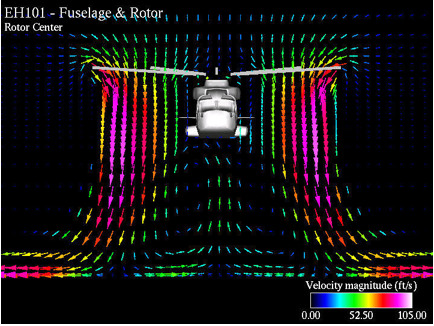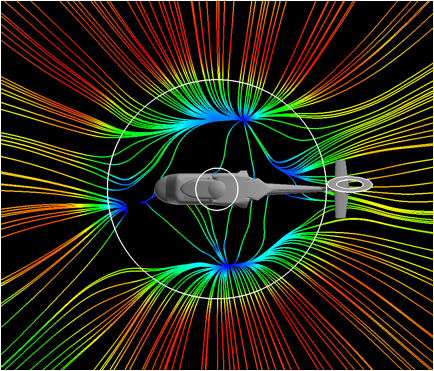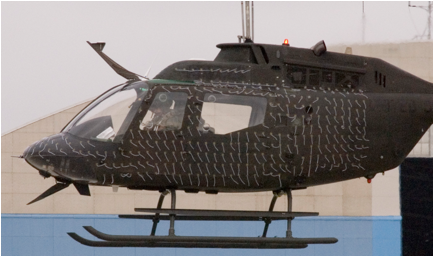Helicopter Brownout Research

This image shows the velocity magnitude for an EH-101 fuselage and rotor (note the flow recirculation beneath the fuselage).

Image of the predicted ground plane surface flow (colored by wall shear magnitude) for a UH-60.

Image of OH-58 Kiowa with hundreds of tufts applied to it. The tuft positions show the flow direction at the instant that the photograph was taken.
Helicopter brownout is a dangerous phenomena experienced by many helicopters when making landing approaches in dusty environments, whereby sand or dust particles become swept up in the rotor outwash and obscure the pilot’s vision of the terrain. This is particularly dangerous because the pilot needs those visual cues from their surroundings in order to make a safe landing. Helicopter brownout is a $100 Million per year problem for the U.S. Military in Afghanistan and Iraq and the Army cites brownout in three out of every four helicopter accidents there.
Several approaches are being utilized at Ames to better understand and mitigate brownout:
Computational Fluid Dynamics (CFD) software is used to predict flow characteristics through the rotor and along the ground plane.
However, even at its best, computer modeling is still only a model and cannot take into account the complexities of the actual flight environment.
For this reason, experimental techniques are used to measure performance characteristics. One of these tests was to apply hundreds of tufts to a ground plane as well as a helicopter fuselage. Images were taken while the helicopter was in hover at various vertical heights above the ground. The tuft positions show the flow direction at the instant that each photograph was taken.
Because of the costs and inherent complexities of performing full-scale tests, some research experiments are performed using scale models. A 1/16th scale model rotor and fuselage were used to conduct a similar small-scale test of a tufted ground plane. A follow-up study was performed using oil drops instead of tufts to visualize the average flow direction and relative shear stress.
Related Publications
Wadcock, A., Ewing, L., Solis,E., Potsdam, M., Rojagopalan, G., "Rotorcraft Downwash Flow Field Study to Understand the Aerodynamics of Helicopter Brownout", presented at AHS Southwest Region Technical Specialists' Meeting, Dallas, TX, Oct 2008. Download If needed: Download Acrobat Reader
Point of Contact
Dr. William Warmbrodt
NASA Ames Research Center
Moffett Field CA 94035-1000